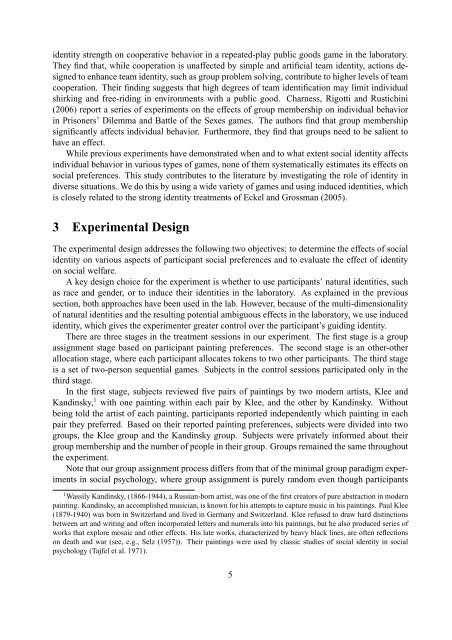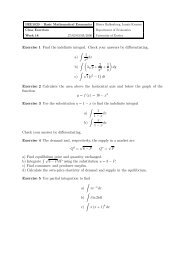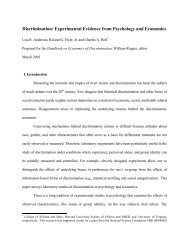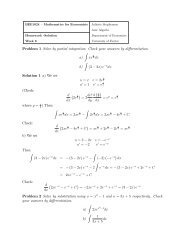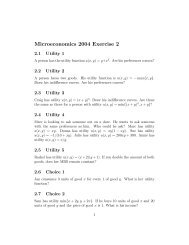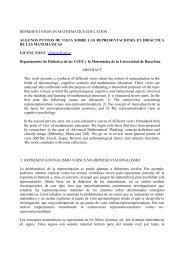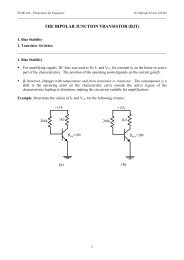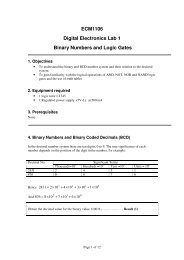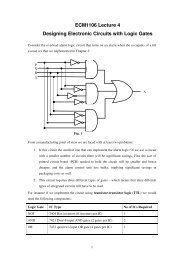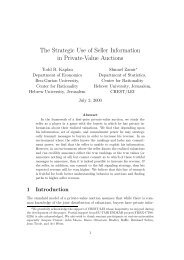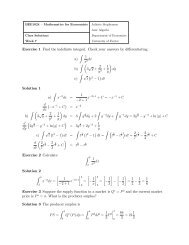Snyder (2003) find that the effect of gender on levels of contribution is significant. Interestingly,Croson et al. (2003) find that, in a threshold public goods game with multiple equilibria, coordination<strong>and</strong> group efficiency increase among women who interact with members of a naturallyoccurring group, while the effects are opposite for men.In experiments using race or ethnicity as the natural identity, results are mixed as well. Forexample, Glaeser, Laibson, Scheinkman <strong>and</strong> Soutter (2000) combine two experiments <strong>and</strong> a surveyto measure levels of trust <strong>and</strong> trustworthiness. They find that in trust games, subjects who arepaired with a partner of a different race or nationality send back less money to their partner. Thisfinding supports the idea that trustworthiness declines across the line of races or nationalities.In another study, Fershtman <strong>and</strong> Gneezy (2001) use various games to study different aspects ofethnic discrimination. They find a systematic mistrust of men of Eastern origin in Israeli Jewishparticipants, <strong>and</strong> identify mistaken ethnic stereotypes (as opposed to a “taste of discrimination”) asthe source of mistrust. Bouckaert <strong>and</strong> Dhaene (2004) adopt a similar approach as in Fershtman <strong>and</strong>Gneezy (2001) but use male small businessmen of distinct ethnic origins to investigate inter-ethnictrust <strong>and</strong> reciprocity in Belgium. They find that trust <strong>and</strong> reciprocity on average are independentof the ethnic origin of either participant or the opposite party. They argue that ethnic biases vanishwhen the two parties of different ethnic origins share enough other characteristics such as gender,socio-professional status <strong>and</strong> place of residence.Two recent studies using natural groups find significant effects of group identity on behavior.Bernhard, Fehr <strong>and</strong> Fischbacher (2006) use a dictator games experiment with third-party punishmentin two distinct, native social groups in Papua New Guinea. They find that third parties showstronger altruism towards ingroup victims <strong>and</strong> give ingroup norm violators more lenient judgments.Relevant to our study, dictators in their study are seen as upholding social norms when theytransfer money to ingroup members. Therefore, ingroup favoritism is a strong force in altruisticnorm enforcement <strong>and</strong> sharing decisions. Goette, Huffman <strong>and</strong> Meier (2006) examine the effectsof group membership in a Prisoner’s Dilemma game using natural groups (platoons) in the SwissArmy. They find more cooperation when subjects interact with ingroup members. In a secondexperiment similar to Bernhard et al. (2006), they also find that third-party punishment is strongerwhen a violation affects an ingroup member as opposed to an outgroup member.In addition to experiments designed to study the effects of natural identities on decision making,there is a large related literature on gender <strong>and</strong> economic decision making. We refer thereaders to the surveys of Croson <strong>and</strong> Gneezy (2004) <strong>and</strong> Eckel <strong>and</strong> Grossman (Forthcoming) for adetailed description of the main results. Another related body of literature examines the economicconsequences of diversity. This literature is based on the idea that an ethnically-mixed communityfaces the trade-off between the benefits of diversity <strong>and</strong> the costs of preference conflicts. Alesina<strong>and</strong> Ferrara (2005) review the main contributions in this area <strong>and</strong> document the effect of ethnicheterogeneity on economic growth, public goods provision, community formation <strong>and</strong> social capital.One problem with using natural identities in experiments is that an individual’s natural identityis associated with multiple social categories. Therefore, a participant in various situations mightidentify with different groups depending on which categories are most salient. For example, aparticipant might be Asian, female, an engineering student, <strong>and</strong> a lesbian. Because of this potentialambiguity, using induced identities can give the experimenter more control over the identityformation process as well as the strength of participant identities.The extent to which induced identity affects behavior depends on the strength of the socialidentity. Eckel <strong>and</strong> Grossman (2005) use induced team identity to study the effects of varying4
identity strength on cooperative behavior in a repeated-play public goods game in the laboratory.They find that, while cooperation is unaffected by simple <strong>and</strong> artificial team identity, actions designedto enhance team identity, such as group problem solving, contribute to higher levels of teamcooperation. Their finding suggests that high degrees of team identification may limit individualshirking <strong>and</strong> free-riding in environments with a public good. Charness, Rigotti <strong>and</strong> Rustichini(2006) report a series of experiments on the effects of group membership on individual behaviorin Prisoners’ Dilemma <strong>and</strong> Battle of the Sexes games. The authors find that group membershipsignificantly affects individual behavior. Furthermore, they find that groups need to be salient tohave an effect.While previous experiments have demonstrated when <strong>and</strong> to what extent social identity affectsindividual behavior in various types of games, none of them systematically estimates its effects onsocial preferences. This study contributes to the literature by investigating the role of identity indiverse situations. We do this by using a wide variety of games <strong>and</strong> using induced identities, whichis closely related to the strong identity treatments of Eckel <strong>and</strong> Grossman (2005).3 Experimental DesignThe experimental design addresses the following two objectives: to determine the effects of socialidentity on various aspects of participant social preferences <strong>and</strong> to evaluate the effect of identityon social welfare.A key design choice for the experiment is whether to use participants’ natural identities, suchas race <strong>and</strong> gender, or to induce their identities in the laboratory. As explained in the previoussection, both approaches have been used in the lab. However, because of the multi-dimensionalityof natural identities <strong>and</strong> the resulting potential ambiguous effects in the laboratory, we use inducedidentity, which gives the experimenter greater control over the participant’s guiding identity.There are three stages in the treatment sessions in our experiment. The first stage is a groupassignment stage based on participant painting preferences. The second stage is an other-otherallocation stage, where each participant allocates tokens to two other participants. The third stageis a set of two-person sequential games. Subjects in the control sessions participated only in thethird stage.In the first stage, subjects reviewed five pairs of paintings by two modern artists, Klee <strong>and</strong>K<strong>and</strong>insky, 1 with one painting within each pair by Klee, <strong>and</strong> the other by K<strong>and</strong>insky. Withoutbeing told the artist of each painting, participants reported independently which painting in eachpair they preferred. Based on their reported painting preferences, subjects were divided into twogroups, the Klee group <strong>and</strong> the K<strong>and</strong>insky group. Subjects were privately informed about theirgroup membership <strong>and</strong> the number of people in their group. <strong>Group</strong>s remained the same throughoutthe experiment.Note that our group assignment process differs from that of the minimal group paradigm experimentsin social psychology, where group assignment is purely r<strong>and</strong>om even though participants1 Wassily K<strong>and</strong>insky, (1866-1944), a Russian-born artist, was one of the first creators of pure abstraction in modernpainting. K<strong>and</strong>insky, an accomplished musician, is known for his attempts to capture music in his paintings. Paul Klee(1879-1940) was born in Switzerl<strong>and</strong> <strong>and</strong> lived in Germany <strong>and</strong> Switzerl<strong>and</strong>. Klee refused to draw hard distinctionsbetween art <strong>and</strong> writing <strong>and</strong> often incorporated letters <strong>and</strong> numerals into his paintings, but he also produced series ofworks that explore mosaic <strong>and</strong> other effects. His late works, characterized by heavy black lines, are often reflectionson death <strong>and</strong> war (see, e.g., Selz (1957)). Their paintings were used by classic studies of social identity in socialpsychology (Tajfel et al. 1971).5
- Page 1 and 2: Group Identity and Social Preferenc
- Page 3: ehavior. Deviations from the prescr
- Page 7 and 8: In our study, the stage of other-ot
- Page 9 and 10: while ρ(1 + a) measures the charit
- Page 11 and 12: Support. In Table 2, column 5 prese
- Page 13 and 14: when A is an outgroup match. When A
- Page 15 and 16: compared to outgroup matching, incr
- Page 17 and 18: By Result 5, we reject Hypothesis 6
- Page 19 and 20: induced identity, when matched with
- Page 21 and 22: APPENDIX A. Sequential Games with S
- Page 23 and 24: Based on your choices, you prefer t
- Page 25 and 26: [New Screen]Please record your deci
- Page 27 and 28: [New Screen, Game 1, Player A]In th
- Page 29 and 30: [New Screen, Game 3, Player B]In th
- Page 31 and 32: Appendix C. Post-Experiment Survey(
- Page 33 and 34: Session # Treatment or Control Game
- Page 35 and 36: Dependent Variables Prob(B rewards
- Page 37 and 38: Dependent Variable:Prob(B Choosing
- Page 39 and 40: Tokens3503002502001501005000 1 2 3
- Page 41 and 42: ReferencesAkerlof, George and Rache


